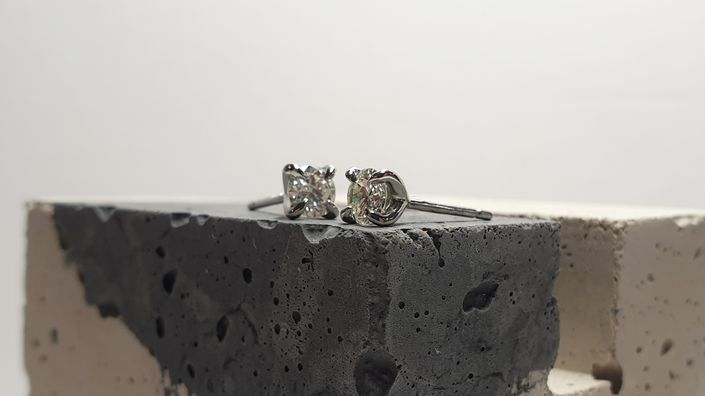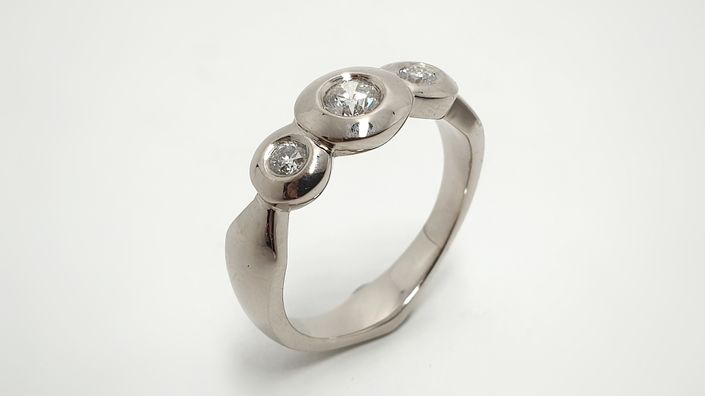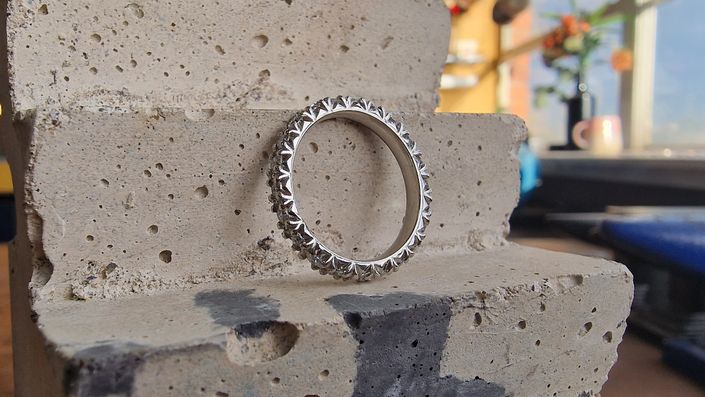Introduction to Shaped setting
Usually what follows setting round stones, is to venture into the world of shaped stones. And what this means is introducing yourself to the dreaded corners! Yikes! A shaped stone is a different animal entirely. Firstly, we don’t have shaped burrs yet [damn you technology], meaning we have to hand cut using scorpers.
To set a shaped stone, we need to respect and deal with corners. A crisp, pointy peak is a true thing of beauty, but is perilous to us setters. It is the natural weak point of the stone, the most obvious place it will snap, shear or crumble. If only everything was as easy to set as a round stone.
In this tutorial, we explore a variety of stone shapes which are set in a few different styles. We try to cover as broad a spectrum as possible, using common shapes of stones with popular styles of setting.
Each of these shapes and styles will be entirely interchangeable, e.g. once you know how to bezel set a pear shape, you can set a square etc, once you can create a V claw for a marquise, you can do it for and stone with a corner.
And remember, we teach at the most economical level. Our skills are absolute proof that you don't need all the fancy kit with bells and whistles to achieve proper, high-end setting. We don't use microscopes, pneumatic tools or fancy ball vices.
Time to have fun!

Pear Shape Bezel

Marquise Claw

Square Flush

What will you learn?
As this is only an introduction, this course focuses on setting only, not any mount-making. We'll be using cast blanks or ready-made materials to bezel set a pear shape, claw set a marquise, and flush set a square. For each of these techniques, the shapes are interchangeable. This means that once you've learned how to bezel set a pear, you can do the same for a square, for example. Once you know how to cope with one corner, you can deal with 'em all! The same goes for claw setting - we'll show you two ways of getting a claw over a stone, which then allows you to deal with claw set pear, marquise, square, brilliant etc, and ditto for flush setting.
What skills do you need?
So, this is another step up yet again from our other content. Obviously, we would need you to be proficient in bezel, claw and flush setting round stones before you take a swipe at this, and maybe even had a go at pavé to understand how accurate you need to be when hand cutting. This is one of our most complex courses, so please make sure you have a first-class knowledge of jewellery techniques before attempting. Having a couple of years at the bench is necessary, as is experience with other forms of making and setting. You’ll need good control with a pendant motor and be competent with drilling holes, plus being proficient and being experienced with scorpers/gravers is a must.

What's possible?
Once you've completed this course, and have practised, practised, practised, what kind of setting work could you achieve?
Well, let's take a look at some previous Vanilla Ink commissions as inspiration.

Different shapes
Use what you now know to set stones of all different shapes and sizes. This cushion cut tourmaline had very gentle corners, rather than pointy, but still needed to be treated gently

Mix it up
Put those new found skills to good use! Mix it up and claw set another shape, like this stunning London blue topaz with conventional claws and a super crisp 'V' claw on the nose of the pear shape.

Go crazy!
Or you could just put everything you've ever learned into one ring! Sometimes there's no rule book and you just gotta set somehow! This pear shape used knowledge from claw, bezel and flush

Meet your tutor
Scott McIntyre is the founder and Creative Director of Vanilla Ink CIC, and a Master Goldsmith and Setter. He is responsible for commissions and class content, leading the creative policies, and shaping how the company looks and sounds. With nearly 30 years of experience in the industry, there isn’t much Scott doesn’t know!
His jewellery journey began early, embarking on an apprenticeship when he was just sixteen in one of Glasgow's top workshops. In his career, he has picked up an extensive set of skills, learning from a variety of other jewellers while creating and finely tuning his own techniques.
After years of plying his trade across Scotland’s Central Belt, he found his calling as a naturally gifted tutor. Scott has a wonderful ability to connect with his students, making sure everyone feels at ease and ensuring that each student leaves his sessions with a far greater knowledge of jewellery making. His abilities, patience and tolerance are famous, as is his love of a life-enhancing playlist. In recent years, his book ‘Stone Setting’ was published. How fancy.
Diagnosed as autistic as an adult, Scott has always been open and honest about his mental health and aims to use his own experiences to help others who are struggling or have had similar issues in the past.
How we teach
How our online classes look and feel, alongside the way you'll learn

Relaxed and personable
Our courses make you feel like we're right there, talking to you. They are relaxed and are filmed in a flowing, uncomplicated way that's easy to follow

Close ups
We realise that this kind of content is tricky and intricate. This means it requires being as close up and personal to the action as possible

Multiple angles
We filmed with multiple cameras to give you the complete experience. The tutorials are delivered with the right shot at the right time
What's included
What you'll need
Tools
Push tool
Dopstick
Setter’s wax
Flat file
Burnisher
Oil / lube
Toothbrush
Optivisors / eye loupe
Shank drill - 1mm, 1.5mm
Ball burr - 1mm, 2mm, 2.5mm
Square graver [2mm - 2.5mm]
Flat scorper [1.5mm approx]
Materials
Pear bezel blank [12mm x 8mm]
Claw marquise blank [12mm x 6mm]
Ring blank [5.5mm x 2.5mm]
12mm x 8mm pear CZ
12mm x 6mm marquise CZ
3mm square CZ
Other Vanilla Ink Courses
Not the course you're looking for? Maybe you'll be interested in our other options





